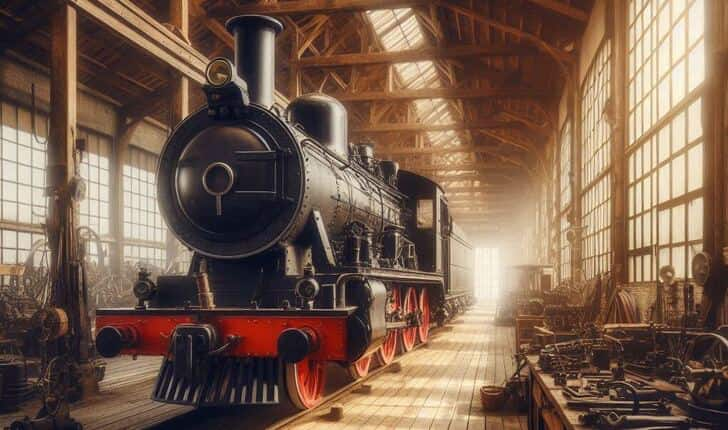I have spent many years exploring diverse engineering ideas, and the concept of creating a choo choo train has always fascinated me. In my view, a choo choo train is not an ordinary vehicle. It is a jet powered dragster that carries the nickname of a train because of its distinctive design and powerful performance. Throughout this guide, I share my insights on how to build one from the ground up.
Sometimes, traditional methods of drag racing leave enthusiasts wanting more. I stumbled upon that by combining aerodynamic principles with modern engineering, you can create a vehicle that is both fast and unique. This article explains the process in clear steps, including design, preparation, assembly, and fine-tuning for performance.
The instructions provided here are based on practical experience and research. Whether you are an experienced builder or a new fan of modified dragster designs, I believe you will find useful tips in these detailed steps. The focus is always on safety, innovation, and excitement.
Step 1: Get Your Design Concept Sorted
Before starting on the build, it is important to clearly define what you want to achieve. Since a choo choo train is a jet powered dragster, the design should merge traditional drag racing elements with a unique visual theme reminiscent of a classic train. Outlining your vision early on makes the project more manageable and ensures that all parts work together in harmony. Taking the time to check out each design element will help avoid surprises further down the line.
Key Design Questions
- What overall look do I want for my vehicle? Should it be rugged, sleek, retro, or futuristic?
- How do I incorporate train-like elements in the body design without hindering performance?
- What size and proportions will step up both aerodynamics and aesthetics?
- How much emphasis should be given to details like color, lighting, or even train windows?
Example Design Goals
- Achieve a clean, streamlined look with subtle train-inspired accents.
- Integrate an engine compartment that blends with the overall design without compromising safety.
- Ensure that every design decision supports both speed and visual impact.
- Make room for performance upgrades while maintaining the original design theme.
By answering these questions, you build a strong foundation for your choo choo train project. The clearer your concept is, the less likely you are to face unexpected challenges during later stages.
Step 2: Establish Technical Specifications
Defining technical specifications is essential for a project of this scale. I approach this step by focusing on the engine, transmission, and overall performance characteristics of the dragster.
Essential Technical Considerations
- Engine Power: How much thrust is needed for that jet-powered performance?
- Aerodynamics: What shape reduces drag and improves stability at high speeds?
- Weight Distribution: How should the weight be balanced to ensure proper handling?
- Cooling and Safety Measures: What are the best strategies to manage heat and ensure operator safety?
Detailed Specification Examples
- Jet Engine: Consider models used in aerospace that can deliver consistent thrust. Research engine specifications to match your design.
- Aerodynamic Elements: Use streamlined bodies and wing structures to minimize air resistance. The smoother the surface, the better the speed.
- Braking System: It is very important to have a high-performance braking system that can handle rapid deceleration given the high speeds involved.
- Safety Circuitry: Include emergency shut-off systems and reliable sensors to monitor temperature, speed, and other performance metrics.
Understanding these technical details not only helps in planning the build but also in ensuring that every choice improves both performance and safety.
Step 3: Choose Materials and Components
Selecting the right materials and components can significantly influence the overall performance and durability of your choo choo train. I always prioritize high-quality materials that balance strength, weight, and cost. Using a careful selection of each component will step up not only performance but also visual appeal.
Core Materials for the Chassis and Body
- Aluminum Alloy: Provides a strong yet lightweight frame, a key element for high-speed performance.
- Carbon Fiber: Offers durability and reduced weight while also being visually appealing.
- Reinforced Steel: Essential for areas requiring additional support, especially near the engine and braking systems.
- Heat-resistant Materials: Use specialized ceramics or composites around the engine area to combat extreme temperatures.
Component Considerations
- Jet Engine Unit: Choose an engine that offers the best combination of power output and reliability. Units that are proven in aerospace can be a good benchmark.
- Aerodynamic Panels: Ensure these panels are designed to reduce drag while maintaining the aesthetic of a classic train. The material should be lightweight and robust.
- Safety Mechanisms: Use components such as fire extinguishers, emergency cut-off switches, and robust braking systems to give a boost to safety.
Studying materials and components in depth can help avoid complications in the build and save time and resources over the long term.
Step 4: Build the Frame and Chassis
Once the specifications and materials have been decided, I begin the construction by building the frame and chassis. This skeletal structure supports every component, so extra attention must be given to quality and precision. Laying out every detail carefully helps the entire assembly process proceed more smoothly.
Building Steps and Tips
- Start with a detailed blueprint that lays out every measurement and connection point. Precision is key to avoid structural mistakes.
- Weld the frame using high-quality, heat-resistant welding techniques to withstand the forces encountered during high speeds.
- Reinforce critical joints. These are areas that will face immense stress during drag racing.
- Keep your work environment organized. Laying out all parts in advance avoids misplacement and ensures that the process moves smoothly.
Real-Life Example
I have used modular chassis designs in past projects to allow for adjustments along the build. Incorporating adjustable mounts provides opportunities for fine-tuning alignment and balance before final assembly.
This phase sets the stage for the rest of the build. A strong, well-built frame is non-negotiable for a safe and fast choo choo train experience.
Step 5: Integrate the Jet Engine and Safety Features
This part of the process combines the source of power with critical safety measures. The jet engine is central to the performance of your dragster, and its integration must be as precise as the rest of the build.
Installation Guidelines
- Mount the engine securely using brackets designed for high stresses. The engine compartment needs to be reinforced to handle the thrust.
- Connect the engine to the fuel and control systems with the precision required for immediate response. Detailed diagrams help during this phase.
- Install cooling systems around the engine. Jet engines can generate significant heat, so safety and performance depend on strong cooling mechanisms.
- Integrate safety shut-off switches that are easily accessible. These switches will instantly cut power in case of an emergency.
Installing Additional Safety Features
- Fire Suppression: I use compact but effective fire suppression units within the engine compartment.
- Sensor Systems: Vibrations, temperature, and pressure sensors constantly monitor the engine and surrounding components.
- Braking Systems: High-performance brakes are installed in positions where they can safely dissipate energy without risking the stability of the vehicle.
Integrating these systems requires careful planning and thorough testing. Every tool and component should work in unison to ensure that both performance and safety are maintained throughout every phase of operation.
Step 6: Test and Tune Performance
No build is complete without a rigorous testing phase. I always believe that thorough testing can reveal issues that might not be apparent at first glance. Testing helps to refine the choo choo train for optimal performance before taking it on the track.
Testing Procedures
- Initial Static Testing: This involves checking all connections, wiring, and welded points while the vehicle remains stationary. I like to perform pressure tests on fuel lines and cooling circuits.
- Low-Speed Trials: Before pushing the dragster to high speeds, I perform controlled runs in a safe environment. This ensures that the engine functions correctly and that the safety systems are responsive.
- High-Speed Tuning: Once basic systems are confirmed to work, I gradually increase the speed while monitoring performance indicators. Data loggers and sensors help pinpoint adjustments needed in engine timing and cooling efficiency.
- Calibration: Fine-tune the aerodynamics by adjusting spoilers and air intakes. Remember that a balance between performance and stability is necessary to achieve the best results.
Performance Adjustments
- Aerodynamics: Use wind tunnel testing reports or computer simulations to further refine the dragster’s profile. Even small tweaks can result in better handling and faster speeds.
- Engine Output: Monitor the engine’s thrust and adjust fuel mixtures if necessary. I have learned that a minor adjustment in the jet engine’s flow rate can significantly affect overall performance.
- Safety Feedback: Incorporate any findings from sensor reports. For instance, if a sensor picks up excessive heat in a particular area, consider adding additional cooling enhancements or protective shields.
Testing is an iterative process. I rarely get everything perfect on the first try, so it is important to be patient and make incremental improvements as data and experience guide you along the way.
Step 7: Maintain and Upgrade
Building your choo choo train is just the beginning of its life cycle. I always emphasize the need to maintain and periodically upgrade the vehicle. Regular upkeep ensures safety and continuous performance improvements over time, making sure that every component runs at its best.
Maintenance Practices
- Regular Inspections: Frequently check engine components, welds, and supporting structures for signs of wear or damage. I schedule inspections after every major run or race event.
- Cleaning: Keep the engine and chassis free from debris, which may include fuel residues or oil spills, as these can affect performance significantly.
- Software Updates: If your system uses computerized controls, update the software regularly to benefit from improved diagnostics and control algorithms.
- Component Replacements: Replace or upgrade parts that have reached the end of their life cycle. This might include jet engine filters, safety sensors, or braking systems.
Opportunities to Upgrade
- Enhanced Engine Performance: Look for improvements in fuel technology or more efficient combustion techniques that can offer additional thrust.
- Aerodynamic Improvements: As new materials or design methods emerge, consider retrofitting your dragster to reduce air resistance even further.
- Technological Additions: Modern sensor arrays or automated control systems may become available. Upgrading these components can keep your vehicle competitive in today’s fast-paced environment.
Every upgrade is an opportunity to learn more about how your choo choo train performs and to experiment with new ideas. Continuous improvement is part of the fun and challenge of this project, and keeping an eye on technological advances can lead to exciting new possibilities.
Common Questions and Troubleshooting
What if I encounter performance issues during testing?
If the vehicle does not perform as expected, begin by reviewing each component in the build. I recommend checking engine output, airflow, and safety systems closely. Often, a small misalignment or an uncalibrated sensor is the cause. Document the issues encountered and test changes one at a time until improvements are observed.
How can I ensure my choo choo train is safe on the track?
Safety is always the top priority. I pay extra attention to structural integrity, engine mounting security, and the proper installation of safety mechanisms. Regular maintenance and strict adherence to testing protocols add layers of safety that cannot be overlooked. It is also useful to ask experienced mechanics or peers who have worked on similar projects for their advice.
What should I do if a part fails during a performance test?
In cases of part failure, immediately shut down the vehicle and perform a detailed inspection. I recommend having replacement parts readily available or knowing where to source compatible components quickly. Learning from a failure is an important part of the building process, so document the issue and adjust your build plan accordingly.
Final Thoughts & Next Steps
Creating a choo choo train, a jet powered dragster with a nostalgic twist, represents a unique blend of art and engineering. I believe that by following these structured steps, you can achieve a vehicle that not only performs remarkably but also stands out visually. Every aspect, from defining the design concept to regular maintenance, contributes to the overall success and enjoyment of the build.
Your Action Plan
- Start by mapping out your design and listing every goal that your choo choo train must achieve. Clarify the visual theme and performance standards you expect.
- Gather technical specifications and select high-quality materials that support both safety and speed.
- Methodically build the chassis and integrate the jet engine along with advanced safety systems.
- Conduct incremental tests to validate design choices, adjusting the aerodynamics and engine performance where needed.
- Implement a regular maintenance schedule and stay updated on emerging upgrades that can further refine your vehicle.
Every project brings its own set of challenges and learning moments. I invite you to take these insights and start planning your own choo choo train build. Which part of this process do you find the most exciting? Explore it further, and continue to refine the design until it matches your vision.
Crystals and Healing Stones Set
7 authentic raw chakra stones
7 tumbled crystals
7 mini tumbled crystals
1 rose quartz crystal ball
1 chakra necklace
1 chakra bracelet
1 rose quartz pendulum
1 selenite charging plate
1 clear quartz point
3 velet bags
50g natural colorful stones assorted
1 electronic starters guide.
We earn a commission if you click this link and make a purchase at no additional cost to you.
Further Considerations and Future Innovations
As you become more comfortable with the build process, it is important to consider how future innovations might impact your choo choo train. Technology is always advancing, and what works best today may be improved upon tomorrow. Take time to keep up with industry developments and research new materials, techniques, and control systems that can further step up both performance and safety. Experimenting with alternative fuel sources or upgraded cooling systems may unlock new levels of speed that you had not reached before.
Looking into advanced sensor networks and automated diagnostics is another area worth exploring. By integrating systems that monitor performance in real time, you can quickly spot any issues and address them before they escalate. This kind of proactive maintenance not only extends the life of your build but also creates opportunities for further upgrades in the future. Each innovation is a chance to learn, adjust, and take your project to the next stage.
Moreover, consider engaging with a community of like-minded builders. Sharing experiences and troubleshooting together can help you gain new perspectives and novel solutions for common challenges. Participation in forums, workshops, or local meet-ups often sparks creative ideas that can be implemented into future projects. The continuous cycle of building, testing, maintaining, and upgrading is what keeps the spirit of innovation alive, ensuring that your choo choo train remains both competitive and ahead of the curve.
By planning for the future and keeping an open mind to new developments, you will not only enjoy the process of building your current dragster but also prepare for the next stage of engineering advancement. The journey of innovation is ongoing, and each improvement can set the stage for more groundbreaking projects down the road.






